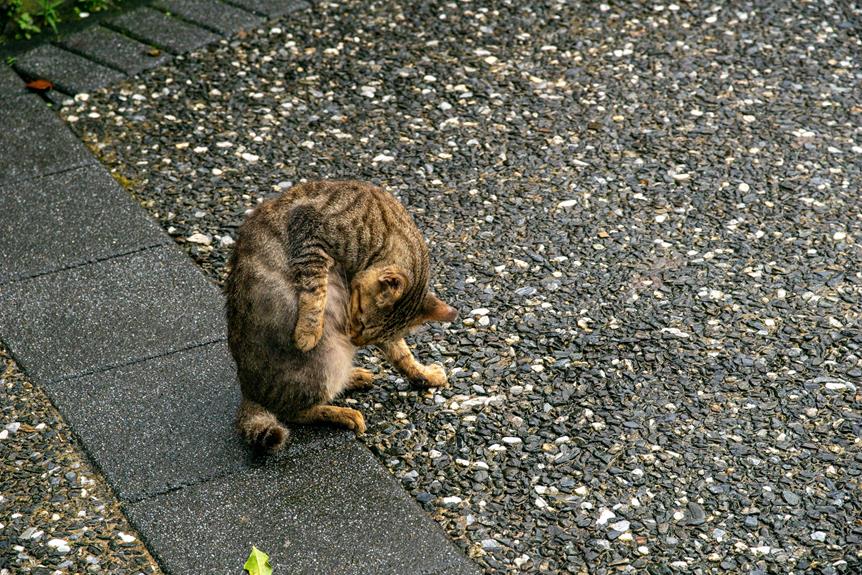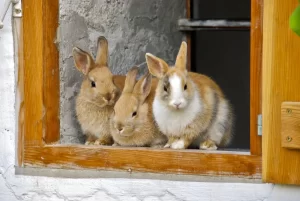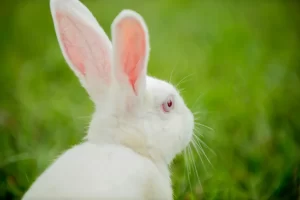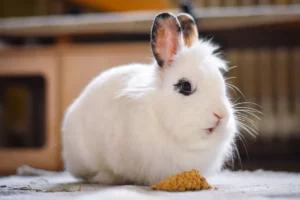Do you ever wonder why rabbits are such avid lickers? Well, it turns out that there are multiple reasons behind this curious behavior.
Rabbits lick not only to groom themselves, but also to establish social bonds, mark their territory, and communicate with other rabbits. Additionally, licking can serve as a form of stress relief and self-soothing behavior.
So, the next time you see your furry friend giving themselves a thorough lick, remember that there’s more to it than meets the eye.
In This Article
Key Takeaways
- Licking is a form of social interaction and communication between rabbits.
- Mutual grooming through licking helps rabbits maintain hygiene and keep their fur in good condition.
- Licking serves as a way for rabbits to mark their scent and territory.
- Licking releases endorphins, promoting relaxation and emotional well-being for rabbits.
Social Bonding
You should spend more time with your friends and family to strengthen your social bonds. Social grooming plays a crucial role in building and maintaining relationships among mammals, including humans. It’s a behavior that involves the physical cleaning and maintenance of each other’s bodies. This act not only serves to keep individuals clean and free from parasites but also promotes trust and cooperation within the group.
Scent recognition is another important aspect of social bonding. Animals, including humans, have the ability to recognize and remember the unique scents of their loved ones. This recognition helps in identifying family members, friends, and even potential mates, facilitating the formation of strong social bonds.
Grooming Behavior
If someone wants to understand grooming behavior, they should observe how animals clean and maintain their bodies. Grooming is a widespread behavior observed in a variety of species, including mammals, birds, and insects. It serves an evolutionary significance by promoting social bonding, removing parasites, and maintaining overall health.
Animals groom themselves and others as a way to strengthen social bonds within their groups. Through grooming, animals engage in physical contact, which fosters trust and cooperation. Additionally, grooming behavior helps to remove parasites such as ticks and fleas from the body, reducing the risk of infections and diseases.
Moreover, grooming stimulates blood circulation and promotes the secretion of natural oils, which keeps the skin and fur in optimal condition. Overall, grooming behavior is essential for maintaining individual and group health in various animal species.
Marking Territory
When an animal marks territory, it leaves behind scent markings to communicate its presence and establish ownership. Scent marking is a common behavior among many species, including mammals like dogs, cats, and even rabbits.
Rabbits, in particular, use scent marking to define their territory and communicate with other rabbits. One way rabbits mark their territory is through urine spraying. By spraying urine, rabbits release pheromones that help them establish their presence and warn other rabbits to stay away.
This behavior is most commonly observed in unneutered male rabbits, as they’ve a higher level of hormones that drive them to mark their territory more aggressively. Understanding scent marking and urine spraying in rabbits can help rabbit owners create a suitable environment that meets their pets’ territorial needs and prevents unwanted behaviors.
Showing Affection
During playtime, rabbits often show affection by nuzzling against you and giving gentle licks. This behavior is known as mutual grooming and is a common form of nurturing behavior among rabbits. It’s their way of showing love and care towards you, as well as seeking comfort and security in your presence.
Here are five reasons why rabbits engage in this affectionate behavior:
- Mutual grooming helps to strengthen the bond between rabbits and their human caregivers.
- It allows rabbits to establish trust and build a sense of security in their relationship with you.
- Gentle licks can also serve as a form of communication, signaling to you that they enjoy your company.
- Mutual grooming helps rabbits to maintain their hygiene by keeping their fur clean and free from dirt or parasites.
- It releases endorphins in both rabbits and humans, promoting a sense of relaxation and well-being.
Communication With Other Rabbits
You can enhance your rabbit’s social interactions by understanding their communication with other rabbits and using it as a guide. Rabbits communicate with each other through a combination of vocalizations, body language, scent marking, and pheromone communication. By observing and interpreting these signals, you can better understand your rabbit’s needs and emotions, and help create a harmonious environment for them.
Here is a table that summarizes some common forms of rabbit communication:
| Communication Method | Meaning |
|---|---|
| Vocalizations | Rabbits use different sounds like purring, growling, and honking to express their emotions and intentions. |
| Body Language | Ears, tail, and body posture can convey various messages such as fear, aggression, or relaxation. |
| Scent Marking | Rabbits mark their territory with urine and feces to communicate ownership and establish boundaries. |
| Pheromone Communication | Through scent glands, rabbits release pheromones that transmit information about their reproductive status, dominance, and social hierarchy. |
Understanding and responding to your rabbit’s communication signals can help strengthen your bond and ensure their well-being. By actively engaging in their social interactions, you can create a happier and more fulfilling life for your furry friend.
Stress Relief
If you feel overwhelmed, taking a few deep breaths can help relieve stress. Stress is a common experience that can negatively impact our physical and mental well-being. However, there are several comforting behaviors that can help reduce anxiety and promote a sense of calm. Here are five evidence-based strategies to consider:
- Engage in deep breathing exercises: Deep breaths can activate the body’s relaxation response and reduce stress hormones.
- Practice mindfulness: Mindfulness involves focusing on the present moment without judgment. It can help reduce anxiety and promote a sense of peace.
- Seek social support: Connecting with loved ones and engaging in meaningful conversations can provide comfort and alleviate stress.
- Engage in physical activity: Exercise releases endorphins, which are natural mood boosters that can help reduce stress and anxiety.
- Practice self-care: Taking care of yourself through activities like getting enough sleep, eating well, and engaging in hobbies can help reduce stress levels.
Taste Testing
Try tasting at least three different flavors and choose your favorite. Flavor preferences can vary greatly from person to person, as our taste buds are unique and constantly evolving. This makes sensory exploration an exciting and rewarding experience. To help you in your flavor journey, here is a table showcasing five different flavors and their corresponding descriptions:
| Flavor | Description |
|---|---|
| Sweet | Pleasingly sugary and rich in taste |
| Salty | Enhances the savory profile of a dish |
| Sour | Tangy and acidic, adds a refreshing kick |
| Bitter | Strong and robust, often found in coffee |
| Umami | Savory and meaty, adds depth to dishes |
Self-Soothing Behavior
Rabbits may engage in self-soothing behavior through the act of grooming and nibbling on objects, providing both comfort and stimulation. It’s believed that these activities help rabbits regulate their emotions and manage anxiety. Here are some key points to consider:
- Emotional regulation: Grooming and nibbling can help rabbits calm themselves down when they’re feeling stressed or anxious. It’s a natural way for them to release tension and find comfort in their surroundings.
- Anxiety management: Rabbits are known to be sensitive animals, and they can easily become anxious in new or unfamiliar situations. Engaging in self-soothing behavior helps them cope with their anxieties and create a sense of security.
- Physical stimulation: Grooming and nibbling on objects also provide rabbits with physical stimulation. It helps keep their teeth in good condition and prevents them from becoming bored or restless.
- Natural instincts: These self-soothing behaviors are deeply ingrained in a rabbit’s instincts. In the wild, rabbits groom themselves and nibble on grass and other plants to stay clean and nourished.
- Bonding and social interaction: Self-soothing behaviors can also be observed in rabbits when they groom or nibble on their companions. It’s a way for them to strengthen their bonds and establish social connections within their group.
Understanding and recognizing these self-soothing behaviors can help us provide a suitable environment for rabbits, promoting their emotional well-being and overall health.
Frequently Asked Questions
Do Rabbits Lick Themselves for Hygienic Purposes?
Rabbits lick themselves for grooming and pleasure. It’s a natural behavior that helps to keep their fur clean. Additionally, rabbits may also lick each other as a social behavior, showing affection and establishing bonds within their group.
Can Rabbits Lick Humans as a Sign of Affection?
Rabbits may lick humans as a sign of affection. Licking is a bonding behavior in rabbits, and grooming plays a crucial role in their social interactions. It’s their way of showing love and connection.
Why Do Rabbits Lick Objects in Their Environment?
Rabbits lick objects in their environment for various reasons. It’s a natural behavior that can have behavioral implications, such as marking territory or exploring. However, it’s important to be cautious of potential health risks from ingesting harmful substances.
Is Excessive Licking a Sign of Stress in Rabbits?
Excessive licking in rabbits can be a sign of stress. It’s important to address this behavior as it may indicate underlying health concerns. Keep an eye out for other behavioral changes and consult a veterinarian for guidance. Remember, “prevention is better than cure.”
Can Rabbits Taste Different Textures and Materials Through Licking?
Rabbits have complex tasting preferences and use licking as a way to explore different textures and materials. This behavior is an essential part of their grooming routine, helping to keep their fur clean and free from debris.
Conclusion
So there you have it, folks. After diving deep into the world of rabbit licking, it becomes clear that these fluffy creatures have quite the complex behavior. From social bonding to taste testing, rabbits use licking as a means to communicate, show affection, and relieve stress.
It’s remarkable how such a seemingly simple act can have such a multitude of purposes. So next time you see a rabbit licking away, remember that behind those cute little whiskers lies a world of scientific wonder.





